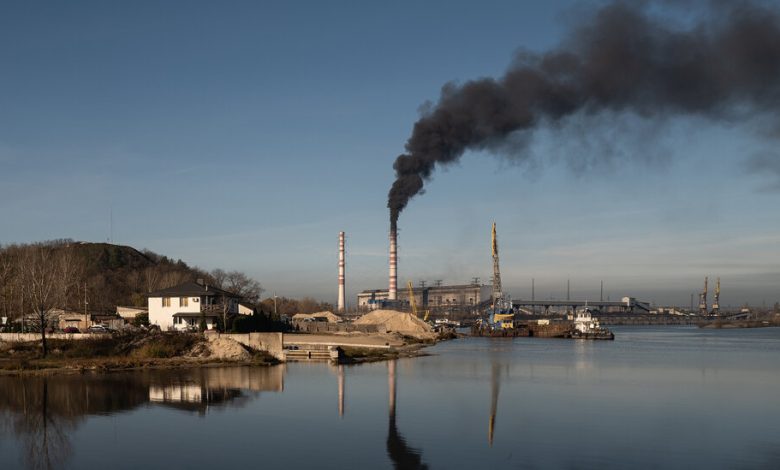Ukraine Heads Into Winter With a Fragile Power Grid

As winter cold sets in across Ukraine, concerns are growing that Russia will soon resume large-scale attacks on the power grid, repeating a tactic it used last year to try to break the will of Ukrainians by plunging them into cold and darkness.
Those fears are compounded by what Ukrainian experts and current and former officials say is an energy system that is more fragile than it was a year ago. In interviews, they described power plants still hobbled by Russian attacks last winter, unfinished repairs to substations and shortages of critical equipment like transformers. And snow has already begun to fall.
The Ukrainian authorities declined to provide detailed data on the current state of the power grid, saying it was sensitive information in wartime. But experts say the situation has improved only marginally since a United Nations report published this summer estimated that Ukraine’s total generation capacity had fallen to half of its prewar level by late April.
“Not a lot has changed since then,” Victoria Voytsitska, a former lawmaker and senior member of the Ukrainian Parliament’s energy committee, said in an interview. “We’re in a much worse situation than last year.”
The situation looks particularly grim for thermal power plants, which are fired by coal or gas and are a key element in Ukraine’s energy mix to meet demand during peak consumption periods, the experts say.
Ukraine’s government says the plants will supply 4.5 gigawatts of power this winter, a third of the country’s prewar output, according to the United Nations. That is the same capacity that the organization estimated this summer, suggesting that there has been little progress in repair work since then.
To be sure, Ukraine has sharply increased its ability to shoot down Russian missiles and drones before they get close to the power grid. It now has powerful air defense systems, and Ukrainian officials say fortifications have been erected around critical energy facilities.
“From one side we are more vulnerable,” said German Galushchenko, Ukraine’s energy minister. “From the other side we are more prepared.”
But some experts and lawmakers say the fortifications are untested and note that in the event of successful attacks, the country’s energy system will have little backup in terms of supply and equipment, making it more likely to break down.
While Moscow has yet to resume large-scale missile strikes, Ukrainian officials have noticed a recent uptick in drone assaults on the power grid. On Saturday, an attack in the southern region of Odesa left some 2,000 families without electricity for several hours.
The strikes come as temperatures drop across Ukraine. Several cities have already seen snow, and the capital, Kyiv, got its first dusting on Tuesday.
Memories of Russia’s air campaign against the power grid last winter still haunt Ukraine.
Moscow launched more than 1,200 missiles and drones against energy facilities between October 2022 and April 2023, according to Ukrenergo, Ukraine’s national electricity operator. By mid-November, nearly half of the country’s power grid had been disabled, plunging people into cold and darkness.
Residents of Kyiv, the capital, were at times forced to rely on flashlights at night and planned for a possible evacuation of the city.
“We had a lot of destruction,” Mr. Galushchenko said in a recent interview at his ministry in Kyiv. He was sitting in a conference room where two large posters showed pictures of smashed power lines and burned-out transformers the size of houses.
Ukraine managed to survive the assaults thanks to air defense systems from Western allies that enabled it to intercept more Russian missiles, round-the-clock work by engineers to repair vital equipment, and the energy-saving ingenuity of residents.
But the attacks left a scar on the power grid, with the Kyiv School of Economics estimating the total damage at $8.8 billion as of June this year.
Mr. Galushchenko said the authorities had invested more than 10 billion Ukrainian hryvnias, or about $280 million, to repair what they could before another winter set in. But like other officials, he acknowledged that a quick return to prewar levels was out of reach.
“It is impossible to fully restore energy facilities built over decades in less than a year,” said Alexei Kucherenko, a deputy chairman of the Parliament’s energy committee.
Volodymyr Kudritskyi, the head of Ukrenergo, said the country had rehabilitated the “low-hanging fruit” — the facilities that have suffered the least damage — but that several power units were only partly repaired.
A major challenge has been finding transformers, which transmit electricity from power stations to people’s homes, he said. Last winter, Russia damaged or destroyed nearly half of Ukraine’s high-voltage transformers, according to the United Nations.
Ukrenergo has hunted for transformers around the world. But they can take up to a year to produce — meaning that only a limited number are likely to have been delivered so far.
Mr. Kudritskyi declined to say how many new transformers his company had received. But he acknowledged in an interview last week that “the safety margin, or safety buffer, is smaller this year if we speak about equipment that is in operation.”
The transformers are so vital that some have been stored beyond Ukraine’s borders, in allied countries, to avoid being targeted by Russia before winter, according to Inna Sovsun, a member of Parliament’s energy committee.
Another challenge facing Ukraine’s power grid is the state of its thermal power plants. While the bulk of the country’s electricity is produced by nuclear power, the thermal plants provide the extra generation capacity needed to meet peak demand.
All of Ukraine’s thermal power plants were damaged by Russian strikes last year, according to the United Nations. Repair work has lagged, several experts said in interviews, partly because Ukraine has struggled to find investors willing to finance plants that are highly polluting.
Roman Nitsovych, research director of DiXi Group, a Ukrainian think tank focusing on the energy sector, said he estimated that the repair work had restored a fifth of the plants’ capacity lost to damage or Russian occupation.
Figures provided by Ukraine’s energy ministry suggest a slightly more critical situation. Although the ministry says it has exceeded its repair targets, only 1.3 gigawatts of capacity has been restored to thermal power plants, about 15 percent of the total loss.
Ukraine’s generation capacity appears crippled to the point that some analysts wonder whether the country will be able to avoid blackouts this winter, even if Russia does not attack.
Viktor Kurtiev, the head of Metropoliya, an energy consulting company, estimated that Ukraine could be short by 1.5 gigawatts during the peak winter consumption period, the amount needed to provide electricity to 10,000 households for a month, “without taking into account new Russian strikes.”
“If the power grid is hit again, these deficits will grow, so it is unlikely that we will avoid rolling blackouts this winter,” Mr. Kurtiev said.
Mr. Galushchenko, the energy minister, and Mr. Kudrytskyi of Ukrenergo said they were confident that the vulnerability of the power grid would be balanced by the new defenses protecting it. Ukraine now uses Western-supplied Patriot surface-to-air missiles that it did not have at the start of last winter and which have proved effective in protecting Kyiv’s skies.
“The best solution for us is the air defenses,” Mr. Galushchenko said. He added that mobile brigades were now operating near crucial energy facilities to shoot down drones.
Ukraine has also built bulwarks around facilities to shield them from direct hits or debris from missiles and drones. Ms. Sovsun, the lawmaker, described it as a multilayered system that includes sandbags, concrete walls and cages filled with rocks.
To what extent these fortifications will prove effective in protecting against attacks remains to be seen, and it is unknown how many facilities across the country will benefit from them.
“We will see how it works,” Mr. Galushchenko said with a smile.
Daria Mitiuk contributed reporting from Kyiv.




